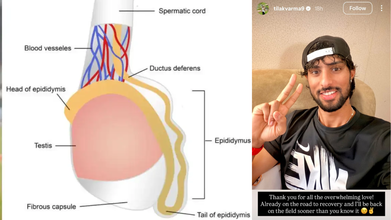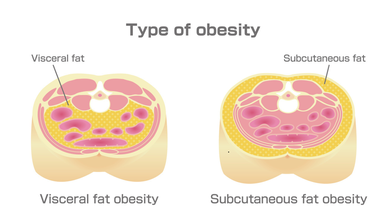- Health Conditions A-Z
- Health & Wellness
- Nutrition
- Fitness
- Health News
- Ayurveda
- Videos
- Medicine A-Z
- Parenting
Couch Potatoes, This Is The Ultimate Lazy Workout That Targets The 'Hidden' Fat- You Can Do It While Lying Down

Image Credits: Canva
Finally, a workout you can do lying down! For those who abhor sweating it out at the gym or braving the intimidation of blaring trainers, there is some good news—fitness exercises now available that allow you to shape your body with little effort while remaining comfortably reclined.
For people who detest rigorous exercise but still desire to remain in shape, this is the epitome of the lazy workout. Whether you are on a mat, lounging on your bed, or binging on a Netflix show, these exercises will keep you getting fitter—without the illusion that you're exercising.
The effectiveness of passive fitness devices, ranging from vibrating belt machines to electronic ab stimulators, has been a topic of debate among experts for years. Yet the most recent lazy exercise methods, based on pilates and resistance training, have proved to be a real winner. The exercises build up underused muscles, burn subtle fat, and can easily be integrated into your daily lifestyle.
Side-Lying Series
One of the best exercises for couch potatoes is the side-lying series, a pilates-based routine that works several muscle groups at once. Fitness experts can suggest this exercise, especially when done with a resistance band.
"Side-lying acts primarily on the outer thighs but also recruits the abs and back muscles to hold the torso steady. It's a fantastic set of movements for gently building core strength, particularly for those with back pain issues in standard exercises," Wilson says.
The side-lying series features a selection of movements such as:
Leg lifts – Acts on the thighs and glutes and activates the core
Clams – Tightens the hip abductors and stabilizes the pelvis
Circles – Improves mobility and flexibility of the hip joint
Bicycle kicks – Tones legs and enhances coordination
How to Do Leg Lifts with a Resistance Band?
To attempt leg lifts, wrap a resistance band around both ankles and lie on your right side with your back straight, hips stacked, legs together, and knees bent at 90 degrees. Slowly lift your top leg while keeping tension in the band, then let it lower slightly before lifting again. Repeat several times before repeating on the opposite side.
For an even more intense burn, Wilson recommends adding ankle weights. This exercise can be done on a pilates reformer, a specialized machine to enhance strength and flexibility while allowing for stability.
Hip Extensions
If you want a low-effort exercise that is sure to give you results, then hip extensions are the way to go. Quadruped hip extensions mainly target the glutes and hamstrings but do engage the abs, back, and arms to stabilize the body.
How to Do Hip Extensions at Home
- Start on all fours, making sure your shoulders are directly over your hands and hips directly over your knees.
- Straighten your spine and activate your core.
- Squeeze your left glute and lift your left leg, keeping the knee bent at a 90-degree angle.
- Suspend yourself in this position for a moment before letting your legs fall back down.
- Do it several times, and then repeat using the right leg.
To increase this exercise, Wilson recommends a resistance band (often called a "booty band") or a reformer machine with a resistance strap. Ankle weights can be added to increase the impact, and you should be feeling the burn on every repetition.
For variety, you can attempt opening the lifted leg out to the side while still keeping it straight, which activates other stabilizing muscles in the thighs and hips.
Why These Exercises Really Work?
Most conventional exercise regimens emphasize high-level workouts that are tough on beginners or mobility-impaired individuals. The side-lying series and hip extensions offer a leaner and more efficient alternative with no sacrifice in effectiveness.
"Personal trainers tend to over-choreograph workouts, but that gets away from what we're supposed to be focusing on. We're not here to invent the wheel—we just want to get the job done," Wilson explains.
One of the greatest benefits of these exercises is that they are effective in attacking visceral fat, or "hidden fat." In contrast to subcutaneous fat, which is located close to the surface of the skin, visceral fat gathers around the organs and has been associated with disease risk, including heart disease, diabetes, and inflammation.
By contracting core muscles, bracing the body, and including controlled movements, these exercises turn on deep-tissue fat-burning mechanisms that standard cardio routines tend to ignore. They also enhance posture, flexibility, and muscle endurance in the long term.
How to Add Lazy Workouts into Your Daily Routine
If it's difficult for you to commit to a fitness routine, the side-lying series and hip extensions can be easily integrated into your daily life. Here's how:
- Wake up your body with a five-minute leg-lift and clam session in bed.
- Do hip extensions on the ground during TV time.
- Cap off your night with some low-key bicycle kicks to get your blood flowing and loosen up the muscles.
So, couch potatoes, rejoice! Your fitness journey doesn't have to include sweat-inducing, heart-pumping workouts. Just lie down, move purposefully, and let your body change—one rep at a time.
Orthopedic Surgeon Reveals Why Your Joints Hurt More During Winters

Credit: Canva
Been wondering why your shoulders, knees or elbows hurt more than usual? Experts say it's due to falling temperatures.
Dr Christopher Murawski, an orthopedic surgeon with Duke Health, has revealed that changes in weather can add pressure to the joints and worsen existing pain.
"Whether it's warm weather, whether it's cold weather, whether it's changes in humidity, changes in pressure and things like that, they do experience joint pains, and muscle pains," he told ABC11.
Typically, joints hurt in the cold because low temperatures thicken the lubricating synovial fluid, a viscous, egg-white-like liquid in movable joints (like knees, hips, shoulders) that lubricates cartilage, reduces friction and provides nutrients, in the body. This makes joints stiffer, causing muscles to tighten.
Moreover, to conserve heat during extreme cold, the body also restricts blood flow which causes muscles and tendons around joints to tighten and pull, increasing discomfort. Less blood flow to extremities also means less warmth and oxygen around the joints, contributing to stiffness and aches.
According to Dr Murawski, the air surrounding us exerts about 15 pounds of pressure per square inch on the body. Any changes in barometric pressure can also increase pressure on the joints and amplify pain
"I'd say, while the science isn't perfect, physiologically, it makes some sense. We get some changes in pressure. The muscles can expand. Ligaments can expand -- things like that. And more importantly, it jives with the experiences that patients share with us even anecdotally and the symptoms they experience," he said.
Who Does It Affect The Most?
People with existing conditions like arthritis (osteoarthritis, rheumatoid arthritis) or past joint injuries feel these effects more acutely.
Those whom have suffered from past injuries, such as ligament strains or cartilage tears, do not exercise frequently and have weak quadriceps and hamstrings may also
become more noticeable to join pain in cold temperatures.
Working from home, sitting with legs crossed or lounging for long periods can also strain the joints as well as drinking less water as dehydration affects cartilage and synovial fluid and increases joint stiffness.
What Can You Do For Relief?
According to Dr Murawski, staying warm, active/mobile and hydrated, even if it is cold outside, is essential to keep the pain manageable. You should visit a doctor if the pain lasts for over three days and occurs several times within a month.
Experts also recommend maintaining weight, focusing on the glutes and hamstrings during exercise and avoiding sitting near cold windows or walking barefoot on cold floors to protect the bones.
Tilak Varma Undergoes Emergency Surgery For Testicular Torsion

Credits: iStock/ Instagram
India's left handed batter, Tilak Varma, 23, has undergone a testicular torsion surgery, after being diagnosed with it. This news has come as a set back to fans. Varma has created a name in cricket through his performance in the Indian Premier League or the IPL.
What Is Testicular Torsion?
It is twisting of spermatic cord, which supports the testes in scrotum. When this occurs the blood supply is cut off to the testicles and nearby tissue in the scrotum. If not treated in time, this could lead to a permanent damage to the testicle.
What Can Cause Testicular Torsion?
Some men could be prone to this due to defects in the connective tissue within the scrotum. This could happen due to an injury to the scrotum, that could lead to lot of swelling or following heavy exercise. While in some cases, there is no clear cause.
The condition is usually common during the first year of life and in the beginning of adolescence or puberty, but it could happen to older men too.
Is Testicular Torsion Common?
Urology Care Foundation notes that this is not a common problem and happens in about 1 in 4,000 males under the age of 25. However, while this condition is not prone to anyone in particular athletes in sports with potential groin or scrotal trauma like cricket, where getting hit by a ball could be common, increases the risk of the condition.
Tilak Varma Update
After his surgery, Tilak Varma has shared an update on his Instagram story: ""Thank you for all the overwhelming love! Already on the road to recovery and I'll be back on the field sooner than you know it."
His diagnosis came after he experienced an acute abdominal pain after breakfast on Wednesday morning in Rajkot, a day before Hyderabad were to play their final Vijay Hazare Trophy league-stage game against Jammu and Kashmir. Varma was then taken to hospital where scans showed that he required an emergency operation. In consultation with the medical team at the BCCI Centre of Excellence in Bengaluru, Varma was finally operated.
"It was a very emergency situation for Tilak to be operated upon, considering the immense pain he was in. Thankfully, the surgery went well on Wednesday evening at a super-speciality hospital in Rajkot. If all goes well, he could well be discharged tomorrow. It will be known in next 1-2 days about his status of playing next month's T20 World Cup," sources told IANS.
A BCCI also released a statement on Thursday that stated that Tilak has been ruled out of the first three New Zealand T20Is. "His availability for the remaining two matches will be assessed based on his progress during the return-to-training and skill phases," the Board said further.
Varma has been a mainstay in India’s T20I line-up, scoring 1,183 runs from 37 innings at an impressive average of 49.29 and a strike rate of 144.09. The left-hander has registered two centuries and six fifties in the format. His absence may push captain Suryakumar Yadav to bat at number three.
This Health Parameter May Be More Important Than BMI or Body Fat, According To Doctor

Credits: iStock
We have been told for long that BMI or the body mass index is the ultimate measurement for your healthy life. However, while it could predict how healthy you will be in the coming years down the line, it is not the only parameter that you should be focused on. In fact, several studies have shown that BMI in fact is not the right parameter, as it does not take in account for one's body type. Tracking the right parameter could actually help flag potential problems long before symptoms even appear. This can give you enough opportunity to intervene through lifestyle changes.
A Bengaluru-based dermatologist, Dr Priyanka Reddy, who is also a cosmetologist and trichologist, and the founder of DNA Skin Clinic and Wellness Centre, highlighted that one crucial health parameter is actually visceral or centripetal fat.
What Is Visceral Fat?
"This is the centripetal or visceral fat - the fat around the abdomen and internal organs. It starts in your late 20s to early 30s and it can predict your future health problems like these and it is closely linked to insulin resistance, poor sleep cycle, stress and other factors like these. This is also called apple-shaped obesity,” she explains.
How To Track Visceral Fat?
Tracking visceral fat does not always require expensive tests. Experts say there are both simple at-home ways and more precise clinical methods to understand whether your levels are in a risky range.
The easiest place to start is waist circumference. For women, a waist size above 80 cm signals higher health risk, while for men the risk increases beyond 90 cm. This measurement is quick, affordable, and surprisingly informative when done correctly and consistently.
Another helpful marker is the waist-to-height ratio. If your waist measurement is more than half your height, meaning a ratio of 0.5 or higher, it is considered unhealthy and linked to higher metabolic risk.
For clinical accuracy, DEXA scans are considered the gold standard. Dual-Energy X-ray Absorptiometry provides a detailed breakdown of fat distribution, including visceral fat stored around organs.
Many people also rely on smart scales, which offer a visceral fat score. A score above 9 may indicate increased risk. However, experts caution that this number should be seen as a trend over time rather than a medical diagnosis.
In general, a healthy waist range is slightly lower than risk cut-offs. For women, a waist below 75 to 80 cm is considered healthy, though risk rises after 40. For men, a waist under 88 to 90 cm is ideal, with risk also increasing after 40.
Why Visceral Fat Increases
Visceral fat builds up due to a combination of lifestyle and hormonal factors. Poor sleep, chronic stress, insulin resistance, low muscle mass, frequent alcohol intake, and diets high in ultra-processed carbohydrates all play a role. Hormonal shifts such as PCOS, menopause, or low testosterone can further worsen fat accumulation around the abdomen.
How to reduce visceral fat
Experts recommend strength training three to four times a week as a non-negotiable habit. This should be combined with Zone 2 cardio and one or two HIIT sessions weekly. Meals should prioritize protein and fibre, while sugary drinks and late-night eating should be minimized. Consistent sleep of seven to eight hours and active stress management through yoga, dance, or breathwork are equally important. Alcohol should be paused if levels are high.
If visceral fat does not reduce despite consistency, it may be time to check for thyroid issues, insulin resistance, high cortisol, or hormonal imbalances.
Long-term maintenance
To keep visceral fat in check, track your waist monthly, lift weights year-round, prioritize sleep, and manage stress before cutting calories. Experts emphasize that visceral fat is a metabolic issue, not just a weight-loss problem. Address the root causes, and fat loss often follows naturally.
© 2024 Bennett, Coleman & Company Limited

